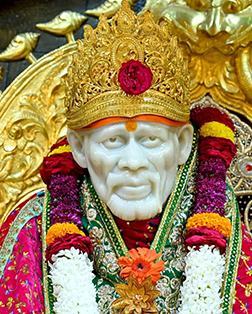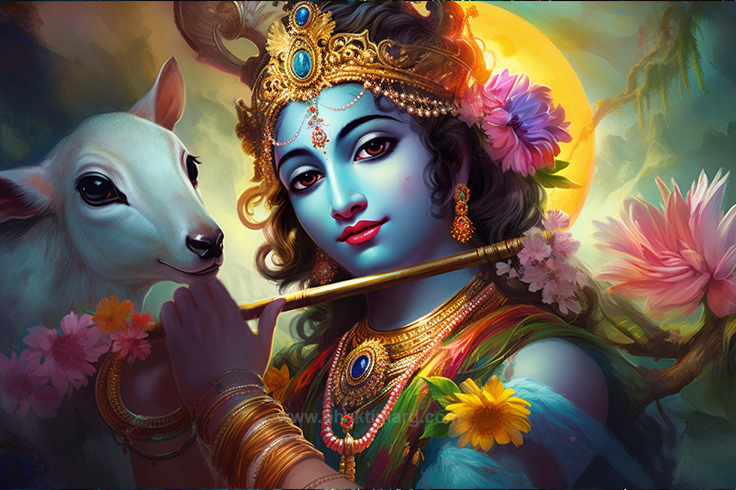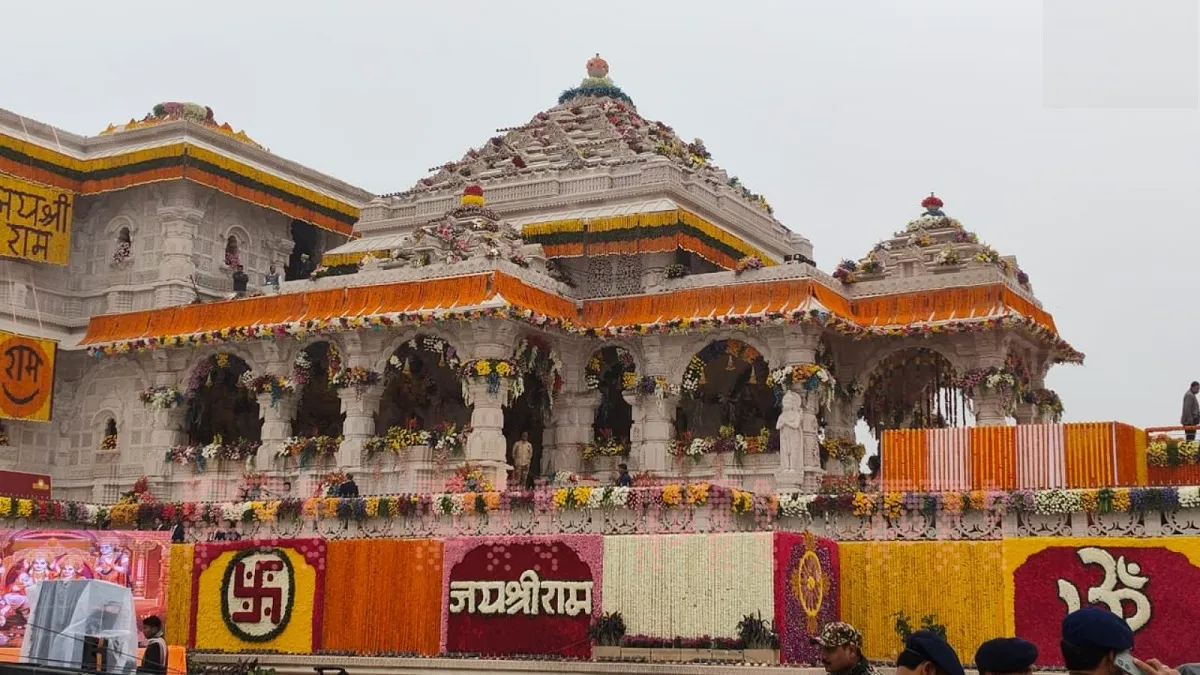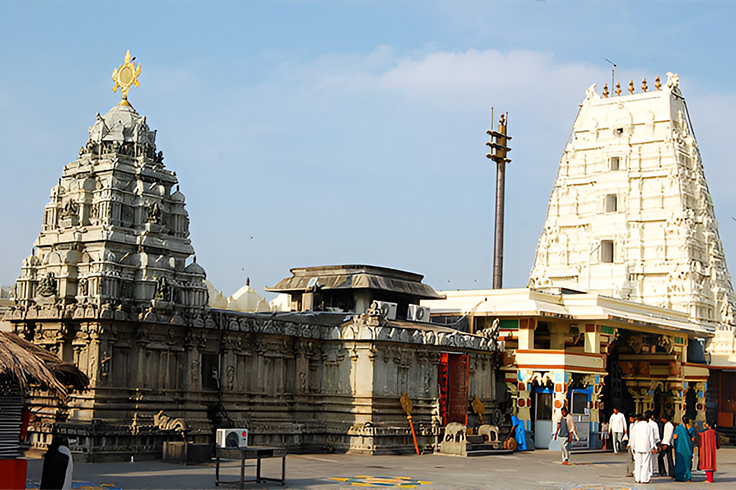
Why is Sanskrit important in Hinduism?
Sanskrit is more than an old language. It is the sacred language of Hinduism and the voice of millions of prayers. Each Sanskrit word holds a distinct vibration. Such sounds have been employed for thousands of years to communicate with the divine. The importance of Sanskrit in Hinduism is not so much historical. It is about living a spiritual life with consciousness and devotion.
From temples to homes, the recitation of a Sanskrit prayer is heard in everyday devotion. They are not merely words spoken. They are felt in the heart. When we know them, we can begin to comprehend how profoundly they influence the spiritual path.
Children in most Hindu homes hear Sanskrit way before they learn what it means. A man may recite Sanskrit mantras during a naming ceremony, wedding, or festival. Without even knowing the words, individuals sense their peace and potency. This is the Sanskrit magic; it addresses the soul before addressing the mind.
Even those who cannot read or write Sanskrit carry these sounds within. The language becomes a silent guide throughout life’s important moments. It brings comfort during challenges and adds joy to celebrations. Sanskrit is like a gentle thread weaving through daily life for many. It holds together tradition and love.
The Divine Origins of Sanskrit

The Sanskrit origin country is India. It has been spoken of for thousands of years. Ancient seers, called rishis, received this language during deep meditation. They did not invent it the way other languages are made. They felt it as a gift from the divine. It came in a state of pure awareness. Almost like it was already there waiting to be heard.
The Vedas, or the earliest Hindu scriptures, were initially transmitted orally. This continued for several generations until they were written down. In this oral mode, every sound was transmitted word-for-word as received.
Even now, instructors ensure that students master the pronunciation perfectly. Every letter and every tone counts. It is said that these sounds possess cosmic energy.
Due to this, Sanskrit is sometimes referred to as the language of the gods. It is not used merely for speaking or writing. The vibrations can penetrate deep into the mind and reach the heart. They can raise the spirits of a person. Even when they do not know the meaning.
The old wise men recognized a connection between Sanskrit and nature itself. The sounds harmonize with the rhythm of the world around us. Like the blowing wind or the chirping of birds. Even every beat of a human heart. This is the reason why chanting in Sanskrit can be so calming. It brings you to a harmony that already exists in life.
And when you chant with devotion, something shifts within. The mind becomes firm. The breath is slow. The heart is lighter. That’s the subtle gift hidden in this ancient tongue.
Sanskrit in the Scriptures

Sanskrit in Hinduism has been the language used for nearly all sacred writings. The Upanishads in Sanskrit contain some of the most profound spiritual truths to have ever been disclosed. They discuss the self, the soul, and the ultimate reality. These are not merely teachings. They are a mirror for anyone on a quest for meaning. For centuries, seekers have come to these lines of poetry for instructions.
One of the world’s longest poems is the Mahabharata. Within it is the Bhagavad Gita. There, Lord Krishna addresses Arjuna in Sanskrit. His message deals with duty, devotion, and wisdom. Many still recite these lines today in times of uncertainty or when faced with fear. They derive strength from the same counsel given to Arjuna.
The Ramayan narrates the life of Lord Rama. It was written by Valmiki. It is about dharma, love, and sacrifice. Then the Ramcharitmanas was composed by Sant Tulsidas in a vernacular language so that all would know the story. But even the original Sanskrit words contain a power of their own. The sound of the words, the rhythm of the words, is some of their power.
It is the very thread that binds these great works together. Sage Veda Vyasa bequeathed us not just the Mahabharata but also the Puranas. Without Sanskrit, the scriptures would not be as we have them today.
When these epics are read out, they possess a rhythm that cannot be replicated in any translation. The sound becomes integral to the narrative. Even a person who does not understand every word can still sense the piety and the vitality. Also, the numinous presence surrounding him or her. And that is the greatness of this language, it speaks beyond meaning. It directly touches the heart.
Sanskrit in Mantras and Slokas

There are various forms of Sanskrit prayers. Some are scriptural verses. Others are recited as spiritual aids. Sanskrit slokas are usually quoted from epics or the Vedas. They glorify God and thank Him.
Sanskrit mantras are not just words. They are formulas in sound employed for spiritual development. Individuals employ Sanskrit mantras for meditation to concentrate the mind. Some of them are lengthy. But others consist of a couple of words.
Worshippers typically chant powerful Sanskrit mantras to invoke blessings. A Lord Shiva mantra in Sanskrit can induce peace of mind, for instance. A Sanskrit Shiva mantra can also eliminate evil. The Krishna mantra in Sanskrit brings happiness and devotion to the heart. The Vishnu Sahasranama Sanskrit glorifies the thousand names of Lord Vishnu. Even yoga exercises employ Surya Namaskar mantras in Sanskrit to pay respects to the Sun.
Most children learn their first Sanskrit slokas from their grandparents. But most family members recite morning prayers, which provides a quiet start to the day. Evening prayers help remove the stress of daily life. There is a wave of devotion in temples created by so many voices chanting together.
Besides temples and homes, Sanskrit mantras have also found a place in many modern spiritual gatherings. People gather in groups to chant together. They believe that the combined energy raises the power of the mantras. Teachers often explain the meaning of these verses. It helps people connect more deeply. Chanting in Sanskrit is not only about tradition; it is also a way to bring calm to your mind. In today’s busy world, it is vital.
Why Sound Matters – The Vibrational Power of Sanskrit

The meaning of Sanskrit is as significant as its sound. Old seers taught that the world itself started with sound. Each syllable produces vibration, and these vibrations are no ordinary ones. They could influence the individual who recites them and the environment they’re in.
Sanskrit mantras harmonize with a natural rhythm in the body when chanted correctly. This is why it’s so critical to learn how to chant correctly. It’s not just about revering tradition. It’s about preserving the energy and the life of the mantra.
In temples, priests chant exactly as their teachers once taught them. This passing of sound from one generation to the next keeps the energy pure. It also creates an atmosphere that makes the mind turn inward and the heart open in devotion.
Think of the sound “Om.” It is simple, and when chanted slowly, it can steady your thoughts. It relaxes your body and fills you with peace. The same is true for other powerful Sanskrit mantras. Each one carries its vibration, its kind of strength.
The sages believed that these sounds connect us with the deeper rhythms of the universe. The hum of Om, the flowing syllables of a prayer, the soft pauses between words, all of them work together. This is the unseen power of Sanskrit. It speaks to the soul in a language beyond meaning.
When chanted together in groups, these vibrations grow even stronger. The combined sound creates an energy that lifts everyone present. That is why group chanting is common in temples and spiritual gatherings. It helps people feel connected not only to each other but also to something much larger than themselves. This shared experience is at the heart of why the Sanskrit sound holds such lasting power.
Sanskrit and the Spread of Devotion
Sanskrit has been carrying the Bhakti message for centuries. Lord Krishna in the Bhagavad Gita talks about surrendering everything in love and honesty. His messages have been read and sung by millions of followers.
Sanskrit slokas transform devotion into more than just a heart feeling. They make it a practice of everyday living. When one recites a mantra every morning, it becomes a soft thread connecting him to God. When one recites a verse, it becomes a reminder of virtues such as compassion and strength. It also boosts the human mind.
Numerous saints have channelled their devotion to the divine into Sanskrit poetry. Some wrote new prayers and poems. Others translated older compositions so that more people could hear them, without degrading the beauty of the original sound. This is the manner in which Sanskrit in Hinduism has maintained the flow of devotion unbroken from generation to generation.
In devotional groups, the energy of sound transcends words. One need not even understand every phrase to be able to join the chant. There is a rhythm that is shared, and the hearts get united. Many voices build into one over time. It is no longer even individuals singing. It is a single voice communicating with the divine.
This unity is the essence that Sanskrit gives to Bhakti. It creates a feeling of togetherness that goes beyond language. It allows devotees to connect not just with God but with each other in a powerful and unseen way.
Sanskrit in Modern Education and Culture

Across India, lots of schools and universities still teach Sanskrit. You’ll find places like Sanskriti University where they don’t just want to keep the language around, but actually get young people excited about it. For instance, many students start their day by saying Sanskrit mantras in their morning prayers. This is a great way to keep the sound and feel of the language fresh in their minds. On top of that, smart people are working hard to translate old Sanskrit books so their ancient knowledge is easy for us to read.
Sanskrit isn’t just for classrooms, though. It’s also super popular in yoga and meditation places all over the world. People from many different countries learn short Sanskrit chants to make their practice stronger. Sometimes, they all chant together. Other times, they just listen to recorded prayers. Either way, this keeps the tradition going strong.
You hear Sanskrit at cultural events too. For example, festivals like Navaratri and Janmashtami often start with Sanskrit chants. The same goes for many weddings and other religious ceremonies. What this shows us is that Sanskrit isn’t some dusty old thing. Instead, it’s still a big part of daily life.
Technology has also given the language a big boost. Now, you can find apps and websites that teach Sanskrit. They have clear audio and video to help you with pronunciation. This means people can learn from their homes, no matter if they live in a big city or a small village. So, technology is basically a bridge between the old days and now. It helps Sanskrit stay relevant for the future.
Many parents even teach simple mantras to their kids early on. These small steps are a huge help in keeping the language alive. Also, schools and local groups often organize chanting events. Children get to join in together. This not only builds their confidence but also creates a shared cultural bond.
Finally, there are also workshops and retreats led by teachers and spiritual leaders. These events bring people of all ages together. They go deeper into the spiritual side of Sanskrit, which you don’t always find in a school book. It’s because of all these things working together that Sanskrit is still a living part of our culture today.
The Living Presence of Sanskrit in Daily Life

Sanskrit even finds unlearned usage in the lives of many Hindus. Phrases such as “Namaste”, “Pranam”, and “Shanti” are derived from this sacred language of Hinduism. They are used in greetings and prayers. Every word not only conveys meaning but also has a soft energy. It reminds others of something greater.
Some recite the Gayatri Mantra in the morning while starting the day. Some may chant Surya Namaskar mantras in Sanskrit and sun prayers while waking up. A short Sanskrit slokas are chanted to thank the god for food at mealtime. A calm prayer or poem before sleeping can calm the mind and prepare it for sleep.
These little things perpetuate the link. They keep Sanskrit alive. They prove that it is not merely a thing of the past. And piety interweaves with the mundane. So, spiritual practice becomes second nature. With time, the sound of Sanskrit sounds as familiar and comforting as a household prayer. It feels passed on from generation to generation.
In temples and even during village festivals, Sanskrit terms are used in songs and tales. They might not be fully understood by all, but they add a religious flavour when used. Hearing them during daily chores reminds people of their origins and traditions.
Grandparents and parents impart little Sanskrit prayers to children more out of love than out of a lesson. These little lessons come with not just words, but values. In them, the language has a home in young hearts, living and breathing for years and years to come.
Even outside formal settings, Sanskrit sounds surround daily life. In markets, fairs, and family gatherings, chants and prayers fill the air. These moments remind people of their roots and create a quiet sense of peace. Sanskrit thus remains alive, weaving spirituality through the fabric of everyday life.
Many communities hold special events where people come together to chant and sing in Sanskrit. These gatherings create a strong bond among participants. The shared rhythm and energy bring a feeling of unity. It is this communal experience that keeps the spirit of Sanskrit vibrant across generations and places.
Conclusion: Living the Spirit of Sanskrit
The history of Sanskrit is not history in the narrow sense. It is the history of a living tradition that influences everyday life. From divine books to morning prayers, it still directs millions.
The importance of Sanskrit in Hinduism is its ability to bring human beings in touch with the sacred. It sounds bear piety. Its words bear knowing. We become a part of a river of prayer that has flowed for millennia when we recite a mantra or repeat a verse.
It is not just a language. It’s heritage. It is memory and faith interwoven. To learn Sanskrit is to connect with the roots of Hinduism. To speak Sanskrit is to keep that alive. And to live it is to allow devotion to guide every step. Through every word and every breath. It reminds us that the holy is never far but is close. It is residing in the very sounds we utter and the prayers we hold dear to our hearts.
The presence of Sanskrit is felt not only in temples but also in homes and communities. Its teachings shape festivals and rituals. This language acts as a bridge, linking people to their culture and spirituality. Through Sanskrit, tradition lives on. Breathing life into every prayer and practice.

















